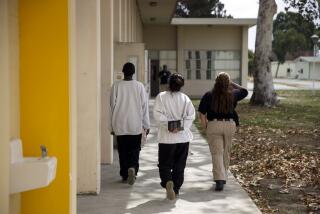At Orangewood, the Numbers Tell a Story
- Share via
After a while, I quit keeping track of parents who wanted to bend my ear about conditions at the Orangewood Children’s Home. The list had grown to a dozen or more and it’s not that I lost interest or that I didn’t believe their stories; it’s just that it was impossible to verify them and the subject just became too depressing.
Frustrating too, because the parents’ complaints were always the same: that their children’s stays at Orangewood--rather than giving the youngsters refuge from an abusive situation--left them worse off than when they went in.
That’s an intriguing premise to write about, but because the whole issue of child-abuse allegations is so fraught with disputed facts and behind-the-scenes wrangling, it’s hard to get a handle on it.
No one favors keeping a child in a dangerous home. Orangewood was set up as a refuge. But in cases where parents hotly disputed that they’d been abusive--and especially when charges later were found to be unfounded--what harm was done to children sequestered from their parents for stays that could stretch into weeks or months?
The parents’ standard lament was as follows: They hadn’t abused their children, but while at Orangewood their children either contracted illnesses, weren’t sleeping and eating properly or were getting into fights with other children.
I often found myself asking the age-old question of whether the cure was worse than the disease. I wrote about it more than once, always incurring the wrath of social service workers who seemed to think I didn’t care about abused children.
This is a long-winded way of leading into the news today that the county has quietly modified its Orangewood thinking.
Shortening Children’s Stays
The average number of children there at any one time last year was less than half the number in 1998. And the figures for 1998 were significantly lower than those for 1997. In addition, the average length of stay has declined from 30 days to 15.
County officials, acknowledging the overcrowded conditions at Orangewood, say they’re trying harder to place dislocated children in the homes of relatives or in foster homes.
The obvious question is why that philosophy took so long to be formalized. Social workers have told me in the past they tried to place youngsters in relatives’ homes while they investigated the parents, but accused parents told me that didn’t happen.
One single-parent father complained long and loud to me that he begged social workers to let his 5-year-old son stay with the boy’s uncle. Social workers refused, saying that wouldn’t prevent the father from having access to his son. His son eventually stayed at Orangewood for 30 days.
Another father to whom I talked this week says he still gets emotional when recalling his son’s 4 1/2-month stay at Orangewood in 1995. His young son had been living with his mother, who then left the state in violation of her custody agreement. When she was found and the boy was returned to Orange County, he was placed at Orangewood although the father insists there were no allegations on record against him and that he wanted the child.
While at Orangewood, the 7-year-old boy contracted chicken pox. The father, who lives in Huntington Beach and now has sole custody of his son, says he’s still looking for someone to write the “whole story” of the situation.
“The thing is, if the parent is abusive, you need to arrest them and put them in jail,” the 33-year-old father says. “Don’t take the child out of the home. Leave them with the non-abusive parent or with grandparents or aunts and uncles--someone who the child knows and trusts.”
Obviously, that is not always possible. Social workers often see the parents as “partners in crime,” even if only one is the actual abuser. And blood relatives often aren’t available or willing to take a child or multiple children.
So the issue is not as clear-cut as frustrated parents might think.
The difficulty in writing about such cases is that social workers say they’re legally prevented from discussing them, leaving only the parent’s version in the public eye.
A fair complaint, but it sounds like the county has been listening.
The drastic reductions in the Orangewood population suggest that maybe those parents’ complaints weren’t so crazy after all.
*
Dana Parsons’ column appears Wednesday, Friday and Sunday. Readers may reach Parsons by calling (714) 966-7821 or by e-mail to dana.parsons@latimes.com.
More to Read
Sign up for Essential California
The most important California stories and recommendations in your inbox every morning.
You may occasionally receive promotional content from the Los Angeles Times.













